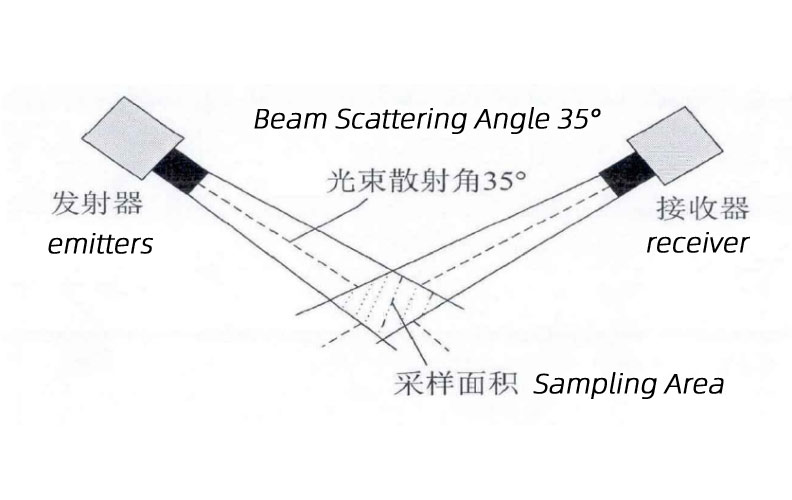

— Products —
 Consumer hotline +8618073152920
Consumer hotline +8618073152920 WhatsApp:+8615367865107
Address:Room 102, District D, Houhu Industrial Park, Yuelu District, Changsha City, Hunan Province, China
All products
Forward scatter visibility sensor is a sensor commonly used to measure atmospheric visibility. It determines visibility by measuring the forward scattering of light by particles in the atmosphere. Specifically, the sensor emits a light beam and then measures how much the beam is scattered in the atmosphere. When particles such as fog, smoke, and dust are present in the atmosphere, these particles scatter light, which results in a reduction in the intensity of the light receiv···
Tel/WhatsApp:+8615367865107
Email:Arvin@niubol.com +Nearly 100 partner company in more than 68 countries. We are committed to providing high-quality, practical products to meet your needs and help you solve problems.Product Details
Forward scatter visibility sensor is a sensor commonly used to measure atmospheric visibility. It determines visibility by measuring the forward scattering of light by particles in the atmosphere. Specifically, the sensor emits a light beam and then measures how much the beam is scattered in the atmosphere. When particles such as fog, smoke, and dust are present in the atmosphere, these particles scatter light, which results in a reduction in the intensity of the light received by the sensor. By measuring how much the light intensity is reduced, the sensor can estimate the concentration of the particles in the atmosphere and thus infer the visibility.

| Supply voltage: | DC12V |
| Signal output: | RS485 |
| Communication protocol: | MODBUS protocol |
| Baud rate: | 9600 |
| Technical principle: | light scattering |
| Scattering angle coverage: | 39o-51o front scattering |
| Peak wavelength: | 875nm |
| Bandwidth: | 100nm |
| Measuring range: | 5-10KM |
| Measurement accuracy: | ≤2km, 2%; 2km-10km, ±10%; |
| Working temperature: | -40-80℃ |
| Working humidity: | 0-95%RH |
| Standard cable length: | 10 metres |
| Size: | 610mm x 230mm x 300mm |
|
Material: |
anodized hard aluminium, with paint protection on the outer surface |
| Protection grade | IP65 |
The following is the principle of operation of a forward scattering visibility sensor.
1. Light source: The sensor emits a beam of light, usually from an LED or laser light source. The beam is directed towards the area to be measured.
2. Scattering: As light travels through the atmosphere, it encounters particles such as dust, water droplets and air molecules. These particles scatter the light in different directions.

3. Forward scattering: Some of the scattered light returns to the sensor in the forward direction. This forward scattering is caused by small particles closer to the sensor.
4. Signal Detection: The sensor detects the intensity of the forward scattered light. The amount of scattering is directly related to the number and size of particles in the path of the beam.
5. Visibility Calculation: The sensor uses the detected forward scattering signal to calculate visibility. The greater the scattering, the lower the visibility.

Forward scattering visibility sensors have a wide range of applications in meteorology, transport and environmental monitoring. They can be used to monitor visibility conditions on roads, airports, harbours and other areas to help decision makers take appropriate measures to ensure traffic safety and normal flight operations. In addition, they can also be used for environmental monitoring to help monitor the diffusion of air pollutants and assess air quality, the following are some common application scenarios:
1. Traffic transport:
- Road traffic: Installing forward scattering visibility sensors on roads can monitor visibility in real time, helping drivers and traffic managers to take appropriate measures, such as slowing down, turning on lights, and adopting traffic control, thus reducing the risk of accidents.
- Air transport: Airports and airlines can use forward scattering visibility sensors to monitor visibility on runways and in flight zones to ensure the safe operation of flights. Low visibility can lead to flight delays or cancellations, so timely and accurate visibility monitoring is critical to the aviation industry.

2. Environmental monitoring:
- Atmospheric pollution monitoring: forward scattering visibility sensors can be used to monitor the dispersion of pollutants in the atmosphere. By monitoring changes in visibility, the concentration of particulate matter in the atmosphere can be inferred, so that air quality can be assessed and appropriate environmental protection measures can be taken.
- Natural disaster monitoring: When natural disasters occur, such as dust storms, haze, fog, etc., forward scattering visibility sensors can be used to monitor the concentration of particulate matter in the atmosphere and changes in visibility in real time, providing early warning information to help people take timely preventive measures.
3. Industrial applications:
- Aviation industry: During aircraft take-off and landing, forward scattering visibility sensors can be used to monitor the visibility of runways and flight areas to ensure flight safety.
- Energy industry: Forward scattering visibility sensors can be used to monitor particulate emissions from combustion processes, helping factories or power plants to monitor and control air pollutant emissions.

The advantages of forward scattering visibility sensors are that they are relatively inexpensive, easy to install, and provide real-time visibility measurements.
Overall, forward scattering visibility sensors play an important role in improving traffic safety, protecting the environment and ensuring safety and efficiency in industrial processes.
Sensors & Weather Stations Catalog
Agriculture Sensors and Weather Stations Catalog-NiuBoL.pdf
Weather Stations Catalog-NiuBoL.pdf
Related recommendations
 Multi-Depth Soil Sensor RS485
Multi-Depth Soil Sensor RS485 TDR Soil Moisture Sensor
TDR Soil Moisture Sensor Pyranometer Solar Radiation Sensors
Pyranometer Solar Radiation Sensors Soil ph sensor
Soil ph sensor Tipping Bucket Rain Gauge
Tipping Bucket Rain Gauge Air Temperature and Humidity Sensor
Air Temperature and Humidity Sensor
Screenshot, WhatsApp to identify the QR code
WhatsApp number:+8615367865107
(Click on WhatsApp to copy and add friends)